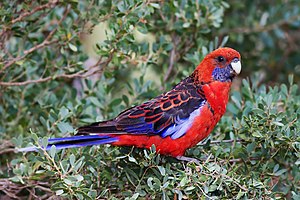Crimson rosella
| Crimson rosella | |
|---|---|
 |
|
| Adult in Wilsons Promontory, Victoria | |
| Scientific classification | |
| Kingdom: | Animalia |
| Phylum: | Chordata |
| Class: | Aves |
| Order: | Psittaciformes |
| Superfamily: | Psittacoidea |
| Family: | Psittaculidae |
| Subfamily: | Platycercinae |
| Tribe: | Platycercini |
| Genus: | Platycercus |
| Species: |
P. elegans Gmelin, 1788 |
| Binomial name | |
|
Platycercus elegans |
|
 |
|
| Crimson rosella range (in red; all-year resident) | |
The crimson rosella (Platycercus elegans) is a parrot native to eastern and south eastern Australia which has been introduced to New Zealand and Norfolk Island. It is commonly found in, but not restricted to, mountain forests and gardens. The species as it now stands has subsumed two former separate species, the yellow rosella and the Adelaide rosella. Molecular studies show one of the three red-coloured races, var. nigrescens is genetically more distinct.
Though described by Johann Friedrich Gmelin in Systema Naturae as Psittacus elegans in 1788, the crimson rosella had been described and named by John Latham in 1781 as the Beautiful Lory, and then Pennantian Parrot. However he did not give it a Latin name until 1790, when he named it Psittacus pennanti. In 1854, it was placed in the genus Platycercus by Martin Lichtenstein in his Nomenclator Avium Musei Zoologici Berolinensis.
Today, the red-coloured races are generally known as the crimson rosella, with the alternate names Red Lowry, Pennant's parakeet, Campbell parakeet, (blue) mountain parrot, (blue) mountain lowry or just plain lowry occasionally heard. Cayley reported that the first two alternate names were most common in the early part of the twentieth century. On Norfolk Island it is called simply red parrot.
The yellow rosella, also known by a variety of alternate common names including Murrumbidgee lowry, murray rosella, swamp lowry and yellow-rumped parakeet, was described as Platycercus flaveolus by John Gould, who gave it the last common name mentioned. It was reduced to subspecies status once hybridization was noted where ranges overlap, however some authorities maintain the hybridization is not widespread and hence preserve its specific status. This view is in the minority, however.
The name blue-cheeked rosella was proposed for the united species elegans, but was not generally taken up.
...
Wikipedia

